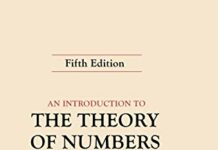
Ebook Info
- Published: 2013
- Number of pages: 78 pages
- Format: PDF
- File Size: 1.84 MB
- Authors: Ivan Niven
Description
This self-contained treatment originated as a series of lectures delivered to the Mathematical Association of America. It covers basic results on homogeneous approximation of real numbers; the analogue for complex numbers; basic results for nonhomogeneous approximation in the real case; the analogue for complex numbers; and fundamental properties of the multiples of an irrational number, for both the fractional and integral parts.The author refrains from the use of continuous fractions and includes basic results in the complex case, a feature often neglected in favor of the real number discussion. Each chapter concludes with a bibliographic account of closely related work; these sections also contain the sources from which the proofs are drawn.
User’s Reviews
Reviews from Amazon users which were colected at the time this book was published on the website:
⭐diophantine approximation is a topic in number theory that deals with the approximation of irrational numbers by rational numbers. for example, the golden ratio [1+sqrt(5)]/2 is approximately 21/13 (or other ratios of fibonacci numbers), which can be easily seen via phi’s continued fraction expansion. niven’s “diophantine approximations” is an extended version of a lecture delivered by the author at a meeting of the mathematical association of america in 1960. at 62 pages sans the front and back matters, it is not meant to be a broad survey of the subject, but rather a self-contained exposition of certain related results, sometimes using non-standard techniques. as such, there are some gems in here for those brave enough to dig in, but the reader will need to have the motivation to do the digging in the first place.niven’s complete avoidance of continued fractions in this book is either a noteworthy feature or a horrendous bug, depending on your preferences. continued fractions hold an honorable position in this topic since convergents, the truncations of continued fractions, are the best approximations of irrationals in some sense. in chapter 1, where certain inequalities are developed to bound the error of an approximation by rationals, niven instead uses the tool of farey sequences in place of continued fractions. this might look ugly to some readers, but it also pays off to some extent. for example, it is well known that the absolute value of the error is bounded by the reciprocal of a product of consecutive denominators of the sequence of convergents. interestingly, if we ditch the absolute value bars, we can form tighter asymmetric bounds, i.e. the upper and lower bounds are of different forms. the author’s approach yields a proof of this fact, which generalizes the symmetric bounds obtained through a standard approach with continued fractions.another unique feature of this book is the generalization of the results in the real number case to that of complex numbers: irrational complex numbers are approximated by rational complex numbers. in this setting, complex integers are just the gaussian integers, and hence rational complex numbers are quotients of complex integers. irrational complex numbers form the complement of the rational complex numbers. diophantine approximation in the complex case is the subject of chapters 4 and 5 of the book. as you might suspect, lattices play a pivotal role here.chapter 3 is perhaps the most interesting to me, though others are unlikely to feel the same. among other things, this chapter covers some structure theorems due to skolem and bang that deal with the integer parts of multiples of irrationals, i.e. what you get by applying the floor function to multiples of irrationals. i was pleasantly surprised to see these results in this book. these theorems could’ve helped with a problem i was working on in my high school days, so i’m happy to have this book as a reference. as niven notes, theorem 3.7 itself is so unknown that it’s been rediscovered by several mathematicians over the years!generally speaking, the proofs in this book can be a bit difficult to read. the reader will see the spirit of minkowski’s geometry of numbers at work throughout the book, despite the fact that only one figure is drawn in this text! this is somewhat quirky, but i suppose the reader can and should draw his/her own pictures. the economical exposition in roughly 60 pages also implies that readers should be ready to supply the missing steps in proofs. however, most of the missing algebra can be done in your head or in the margins of the book. (yes, really. i’m lookin’ at you, fermat.) the greatest difficulty in reading the proofs is probably attributable to the lack of motivation in some cases, as if constants and expressions are obtained out of thin air by “magic.” however, to be fair, i will paraphrase one of my programming professors: “first get it to work, then worry about elegance later.”sometimes typography becomes a problem with older mathematical texts. springer is generally good about typesetting, but it’s hit or miss with other publishers. (artin’s book on galois theory and atiyah/macdonald’s book on commutative algebra come to mind as two examples where the excellent content is done a tremendous disservice by the atrocious typesetting.) fortunately, niven’s book looks good, even by modern standards. nevertheless, there are a few obvious typos that haunt the text. the careful reader should be able to exorcise them without too much difficulty.overall, this book contains some intriguing results that are not widely known and is thus recommended to all patient lovers of numbers. niven’s approach and choice of topics seem unorthodox enough to avoid excessive overlap with other number theory books. given the cheap cover price, there’s very little reason not to have this book on your bookshelf if you’re even remotely interested in any of the concepts covered. lastly, if you wish to read more about continued fractions, check out the two books by khinchin and olds, both aptly titled “continued fractions.”
⭐I really was interested in the topics in this small book, however right off the bat on page 12 there is a reference to a “Theorem 1.8”. There is no theorem 1.8. I guess the reference is to lemma 1.8, which does exist. Simple, inconsequential blunders like this are annoying because they could easily imply more egregious errors elsewhere. I hope this isn’t going to be the case.
⭐The book would have been useful somewhat 50 years ago but is to dated to be useful now. Historically it might hold some interest.
Keywords
Free Download Diophantine Approximations (Dover Books on Mathematics) in PDF format
Diophantine Approximations (Dover Books on Mathematics) PDF Free Download
Download Diophantine Approximations (Dover Books on Mathematics) 2013 PDF Free
Diophantine Approximations (Dover Books on Mathematics) 2013 PDF Free Download
Download Diophantine Approximations (Dover Books on Mathematics) PDF
Free Download Ebook Diophantine Approximations (Dover Books on Mathematics)

